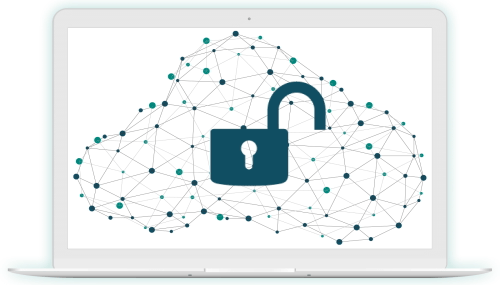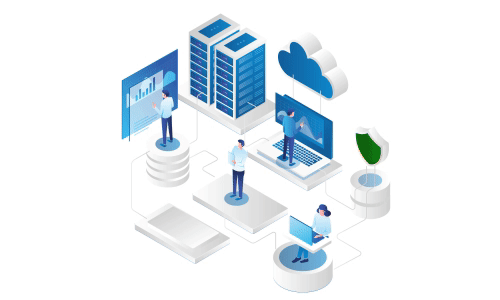In an era where cloud computing has revolutionized how we store, manage, and access data, ensuring the security of this data has never been more vital. 'Cloud Data Security Guide' takes you on a comprehensive journey through the complex landscape of data security on cloud computing. It aims to demystify the common security issues, risks inherent to cloud computing, and the importance of robust infrastructure security. This guide also highlights the crucial role professional development - through certifications and courses - plays in elevating your expertise. Whether you're an aspiring cloud security engineer, an IT professional seeking to deepen your knowledge, or a business owner wanting to safeguard your data in the cloud, this guide serves as your comprehensive resource to understand and navigate the realm of cloud data security.

Let's start with cloud computing.
Cloud computing, in simple terms, is the delivery of computing services like storage, software, databases, networking, analytics, and more, over the Internet or "the cloud". Instead of owning their own data centers or computing infrastructure, businesses and individuals can access these services on an on-demand basis, similar to how we use electricity from the grid. This allows for cost savings, increased productivity, speed and efficiency, performance, and scalability.
Why is data security crucial in cloud computing?
In the context of cloud computing, data security becomes exceptionally crucial due to the very nature of the service. As data is stored off-premises, typically in a shared environment, it is susceptible to various security risks. Unauthorized access, data breaches, data loss, or leakage can lead to significant business damage including financial losses, damage to reputation, and legal implications. Furthermore, as regulatory requirements for data protection tighten globally, ensuring data security in cloud computing is not just important, it's an absolute necessity.
When moving to cloud computing, organizations need to be aware of a range of potential security risks. These risks can have far-reaching implications for businesses, making it critical to understand and manage them effectively. Let's take a closer look to the risks that we listed above.
One of the most significant risks associated with cloud computing is data breaches. A breach can lead to substantial financial losses, reputational damage, and regulatory repercussions. Breaches can result from a variety of factors, including insufficient access management, insecure interfaces and APIs, and account hijacking. It's important to ensure robust access controls, secure all interfaces, and implement strong account security measures to mitigate this risk.
Another common risk is that of system vulnerabilities. These are exploitable bugs in systems that attackers can use to infiltrate your data. Regular security assessments, vulnerability scanning, and timely patch management are essential in mitigating this risk.
Misconfigurations are a major source of cloud security incidents. Accidental exposure of data, unauthorized access, or service disruptions can occur due to user error or poor configuration practices. Organizations should enforce strict configuration management practices and invest in automated tools to detect and correct misconfigurations.
In the cloud environment, malware injections can also pose a risk. Attackers can embed malware into a cloud service, which can then propagate across systems and networks. Investing in robust anti-malware solutions, intrusion detection systems, and ensuring secure code practices can help mitigate this risk.
Another crucial risk is data loss. Data could be lost through accidental deletion, a malicious attack, or a catastrophic system failure. Having a comprehensive data backup and disaster recovery plan in place is essential in cloud computing.
Finally, the risk of insufficient due diligence can't be overlooked. Often, organizations move to the cloud without fully understanding the environment and associated risks. It's essential to conduct a thorough assessment before transitioning any services or data to the cloud.
Understanding these cloud computing security risks is the first step in securing your cloud environment. By remaining vigilant, implementing strong security measures, and conducting regular audits, organizations can significantly mitigate these risks and ensure the security of their data on the cloud.

Now, let's examine some of the recommended techniques and best practices for securing cloud computing infrastructure:
But first, if you want to learn more about cloud security, this blog post is the perfect guide for you: Cloud Security Frameworks, Principles, Patterns and Certifications. By reading this article, you'll learn how the (ISC)² Practitioner Certificate in Cloud Security training can equip you with the expertise to safeguard cloud environments effectively.
Cloud security trends have become crucial in protecting data, applications, and infrastructure from potential threats as the digital ecosystem continues to evolve quickly. These are the most interesting trends of this year so far:
Suggested Reading: The Ultimate Guide to Cloud Security
Obtaining a cloud security certification offers substantial benefits in today's tech-centric world. It not only enhances your knowledge and skills in cloud security but also validates your expertise to potential employers. With cyber threats on the rise, organizations are actively seeking professionals who are certified in cloud security to safeguard their data and systems. A cloud security certification can set you apart in the competitive job market, leading to better job opportunities, higher salaries, and career growth. Moreover, the certification process itself equips you with the ability to tackle real-world security challenges, making you an invaluable asset in any organization's cybersecurity strategy. In essence, a cloud security certification is an investment in your career that yields both immediate and long-term dividends.
Click here to explore our Internationally Accredited Cloud Security Certifications and Courses.
What are the job responsibilities of a cloud security engineer?
A cloud security engineer plays a critical role in safeguarding an organization's cloud computing environment. They shoulder the responsibility of designing, developing, and managing the security of cloud-based systems and platforms. Here are some of the main responsibilities of a cloud security engineer:
The role of a cloud security engineer is complex and challenging, but it's also incredibly rewarding. Becoming a cloud security engineer offers several compelling advantages. It provides the opportunity to work at the forefront of technology in an ever-evolving field, making it an exciting career choice for tech enthusiasts. The role also offers a high earning potential, as organizations are willing to invest in skilled professionals to safeguard their digital assets. Lastly, as the demand for cloud security experts outstrips supply, job security and opportunities for advancement in this field are considerable, offering a rewarding and prosperous career path.

In conclusion, the importance of data security on cloud computing cannot be overstated. As we've explored, there are numerous cloud computing security issues and risks that require skilled professionals to manage effectively. A strong understanding of cloud computing infrastructure security is crucial in today's digitally connected world. By investing in cloud security certifications and courses, like the ones we offer at Bilginç IT Academy, you can build a robust skill set and become an asset to any organization. Whether you're an aspiring cloud security engineer or a seasoned IT professional looking to educate their team, our comprehensive cloud security courses will satisfy your needs.